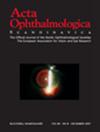Impact of time to idebenone initiation on visual acuity in leber hereditary optic neuropathy: Post hoc analysis of the leros study
Abstract
Aims/Purpose: It is not yet established whether time of idebenone treatment initiation from symptom onset (Ti) impacts the clinical outcome of patients with Leber hereditary optic neuropathy (LHON). LEROS, a Phase IV, open-label, international, natural-history controlled study (NCT02774005), assessed the long-term efficacy of idebenone in the treatment of LHON.1 In this post-hoc analysis of LEROS study data, we report visual acuity (VA) endpoints by Ti.
Methods: VA endpoints at last visit were assessed as previously described, in idebenone-treated eyes from the LEROS study with an observation time of 12–24 months (m) and a m.11778G > A mitochondrial DNA mutation.1 In this post-hoc analysis, eyes were stratified by Ti. No statistical comparisons were performed.
Results: Median [range, n] age at baseline was similar regardless of Ti (0–3m: 32.2y [12.6–49.6, 10]; 3–6m: 36.2y [12.6–62.5, 21]; 6–9m: 37.4y [12.6–64.5, 20]; 9–12m: 33.0y [19.5–49.6, 19]; 12–24m: 32.4y [12.1–60.2, 44]; > 24m: 34.7y [12.4–62.4, 61]). VA endpoints at last visit were also similar regardless of Ti; however, minor differences were observed. Eyes that were 3–6m from symptom onset at treatment initiation had the best median [interquartile range (IQR)] VA at last visit (0–3m: 1.27 [0.40–1.68]; 3–6m: 1.22 [0.30–1.80]; 6–9m: 1.40 [1.02–1.56]; 9–12m: 1.52 [0.98–1.60]; 12–24m: 1.39 [0.58–1.74]; > 24m: 1.32 [0.90–1.62]) and the best median [IQR] VA change from last visit to baseline (0–3m: 0.08 [-0.20–0.62]; 3–6m: -0.20 [-0.46–0.10]; 6–9m: -0.11 [-0.19–0.00]; 9–12m: -0.10 [-0.48– -0.04]; 12–24m: -0.09 [-0.47–0.00]; > 24m: -0.06 [-0.18–0.00]).
Conclusions: LEROS study data provides important insights into the impact of time of treatment initiation on VA outcome. However, given the small number of eyes and large variation in the data, caution must be taken in interpreting these results.
References
1. Yu-Wai-Man P et al. Cell Rep Med. 2024;5:101437.

 求助内容:
求助内容: 应助结果提醒方式:
应助结果提醒方式:


